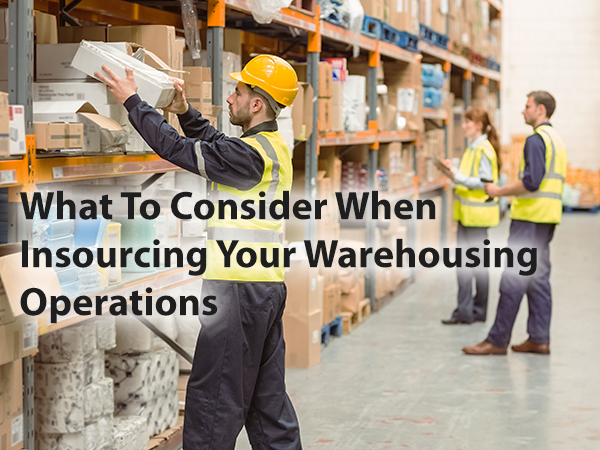Once it becomes large enough, a distribution business may choose to shift its fulfilment operations to a third-party logistics (3PL) provider.
Outsourcing in this way brings a number of benefits. But, there are disadvantages too. We’ve recently had a number of our customers bring their warehousing and fulfilment operations back in-house. By insourcing these activities, they are seeing cost and efficiency benefits that on the face of it might seem counterintuitive to the outsourcing argument.
Is 3PL always the right way to go? Would it be better for you to bring your warehousing and order fulfilment back in-house?
Why Use a Third-Party Logistics (3PL) Provider?
3PL is used by large companies that have an expanding number of products and a need to deliver across the country, or even in a growing number of international markets.
A 3PL can provide a first-rate distribution service, efficiently getting products to the customer. Due to a 3PL’s size and experience, it can bring economies of scale for a distribution business, offering a more cost-effective solution for their warehousing and logistics.
In turn, this allows the company to focus on its core business and removes the headache of managing stock and deliveries.
Why Consider Insourcing for Your Warehouse Operations?
3PLs aren’t always the answer, there are pros and cons. Some distributors find that they have disadvantages and so look to bringing their warehousing operations back in-house.
Doing things internally may come as a result of not receiving the kind of service that you had expected from your 3PL provider. With any business relationship, there are customer expectations that need to be met.
Or perhaps the 3PL is not proving to be as cost-effective as you had hoped. Maybe their prices have increased more over time than you had anticipated, and you now believe that running an internal logistics operation would be more profitable.
Or maybe you want to leverage other benefits of running your own operations, like the ability to run bespoke quality control processes, or to gain direct control over your operations.
As warehousing technology, particularly for SMEs, becomes more cost effective and offers advanced functionality, the benefits of using a 3PL may begin to weaken. Distributors can use the available technology to run just as effective an operation as a 3PL, often with a considerable saving. That’s what we’ve seen with some of our customer recently who have chosen to bring their warehouse operations back in house.
Considerations When Insourcing Your Warehouse Operations
If you’re in the same situation, here’s what you might need to consider if you’re looking at insourcing your warehousing, order fulfilment and logistics.
- Warehouse location is key to a successful operation. You need to consider where both your micro-environment of suppliers and customers are located in order to determine where it would be best to locate your warehousing operation. Maybe having multiple distribution centres might be more cost-effective, for example.
- Warehouse design is another consideration. You must analyse which picking methodology you will use, what type of racking would be best and which warehouse automation technology (conveyors, packing or even robotics) might prove to be the most cost-effective.
- Of course, choosing the right warehouse management system (WMS) is pivotal. Your WMS runs your warehouse. You need to consider whether you need a basic module for inventory management, or perhaps a standalone solution that can leverage core or even advanced WMS capabilities. And you how will your software integrate with your current enterprise solution?
- Staffing represents a significant proportion of any business’s costs. When you bring your operations in-house, you will need to estimate how many warehouse operatives will you require, and what sort of shift patterns you will need to run.
- Finally, how will you manage your last mile operations? Will you run an internal fleet or utilise a carrier operation? This will in turn influence whether you will require a transport management system (TMS) or a carrier integration system.
3PL or in-house warehousing – which is right for you?
3PL isn’t right for every business. And even those that have switched to using a 3PL have later found that bringing operations in–house can bring them greater control, improved productivity and ultimately more profit.
Suppose you’re looking to move away from outsourced operations. In that case, Balloon One can help you with all aspects of insourcing: from warehouse and logistics analysis to systems that can run your warehouse, your controls, your transport and carriers. As a one-stop shop for the supply chain, we offer an easy alternative to a 3PL operation.
For more information, call us on 020 8819 9071 or get in touch.
Conclusion: Balancing the Pros and Cons
Determining whether to outsource to a 3PL or an in house warehouse operations is a nuanced decision, influenced by factors such as business size, growth trajectory, operational complexity, and specific needs. By thoroughly evaluating the pros and cons, considering your long-term goals, and analyzing your current and future operational requirements, you can make an informed decision that aligns with your business objectives.
Key Takeaways:
- Understand Your Needs: Clearly identify your business’s primary needs—whether it’s the scalability and advanced technology of a 3PL or the control and customization of in-house operations.
- Evaluate Costs: Assess both short-term and long-term costs, including initial investments, ongoing operational expenses, and potential savings.
- Focus on Customer Satisfaction: Ensure that your chosen strategy aligns with your commitment to exceptional customer service and satisfaction.
- Leverage Technology: Utilize technology to your advantage, whether through a sophisticated WMS for in-house operations or by leveraging the advanced systems of a 3PL.
In the dynamic landscape of eCommerce and distribution, staying agile and responsive to market demands is crucial. Whether you choose to outsourcing or insourcing, the ultimate goal is to develop a logistics strategy that supports business growth and enhances competitive advantage.
